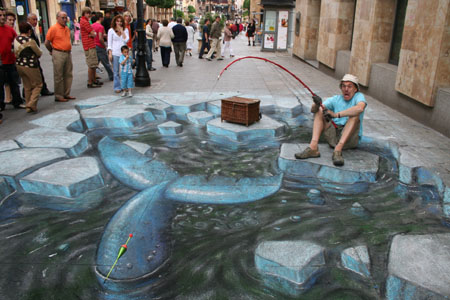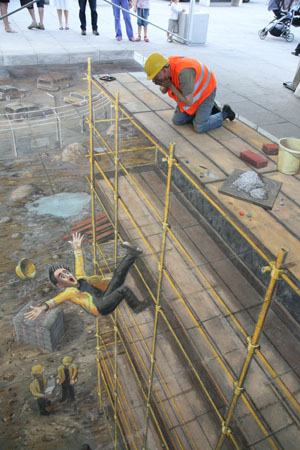Deaerator
A deaerator is a device that is widely used for the removal of air and other dissolved gases from the feedwater to steam-generating boilers. In particular, dissolved oxygen in boiler feedwaters will cause serious corrosion damage in steam systems by attaching to the walls of metal piping and other metallic equipment and forming oxides (rust). Water also combines with any dissolved carbon dioxide to form carbonic acid that causes further corrosion. Most deaerators are designed to emove oxygen down to levels of 7 ppb by weight (0.0005 cm³/L) or less.
There are two basic types of deaerators, the tray-type and the spray-type.
Tray-type deaerator:
Figure 1: A schematic diagram of a typical tray-type deaerator.
The typical horizontal tray-type deaerator in Figure 1 has a vertical domed deaeration section mounted above a horizontal boiler feedwater storage vessel. Boiler feedwater enters the vertical dearation section above the perforated trays and flows downward through the perforations. Low-pressure dearation steam enters below the perforated trays and flows upward through the perforations. Some designs use various types of packing material, rather than perforated trays, to provide good contact and mixing between the steam and the boiler feed water.
The steam strips the dissolved gas from the boiler feedwater and exits via the vent at the top of the domed section. Some designs may include a vent condenser to trap and recover any water entrained in the vented gas. The vent line usually includes a valve and just enough steam is allowed to escape with the vented gases to provide a small and visible telltale plume of steam.
The deaerated water flows down into the horizontal storage vessel from where it is pumped to the steam generating boiler system. Low-pressure heating steam, which enters the horizontal vessel through a sparger pipe in the bottom of the vessel, is provided to keep the stored boiler feedwater warm. External insulation of the vessel is typically provided to minimize heat loss.
Spray-type deaerator:
Figure 2
As shown in Figure 2, the typical spray-type deaerator is a horizontal vessel which has a preheating section (E) and a deaeration section (F). The two sections are separated by a baffle(C). Low-pressure steam enters the vessel through a sparger in the bottom of the vessel.
The boiler feedwater is sprayed into section (E) where it is preheated by the rising steam from the sparger. The purpose of the feedwater spray nozzle (A) and the preheat section is to heat the boiler feedwater to its saturation temperature to facilitate stripping out the dissolved gases in the following deaeration section.
The preheated feedwater then flows into the dearation section (F), where it is deaerated by the steam rising from the sparger system. The gases stripped out of the water exit via the vent at the top of the vessel. Again, some designs may include a vent condenser to trap and recover any water entrained in the vented gas. Also again, the vent line usually includes a valve and just enough steam is allowed to escape with the vented gases to provide a small and visible telltale plume of steam
The deaerated boiler feedwater is pumped from the bottom of the vessel to the steam generating boiler system.
Deaeration steam:
The deaerators in the steam generating systems of most thermal power plants use low pressure steam obtained from an extraction point in their steam turbine system. However, the steam generators in many large industrial facilities such as petroleum refineries may use whatever low-pressure steam is available.
Oxygen scavengers:
Oxygen scavenging chemicals are very often added to the deaerated boiler feedwater to remove any last traces of oxygen that were not removed by the deaerator. The most commonly used oxygen scavenger is sodium sulfite (Na2SO3). It is very effective and rapidly reacts with traces of oxygen to form sodium sulfate (Na2SO4) which is non-scaling. Another widely used oxygen scavenger is hydrazine (N2H4).
Other scavengers include 1,3-diaminourea (also known as carbohydrazide), diethylhydroxylamine (DEHA), nitriloacetic acid (NTA), ethylenediaminetetraacetic acid (EDTA), and hydroquinone.
Boiler Feed Water
Boiler feedwater is water used to supply ("feed") a boiler to generate steam or hot water. At thermal power stations the feedwater is usually stored, pre-heated and conditioned in a feedwater tank and forwarded into the boiler by a boiler feedwater pump.
The water required for boiler feed purposes i.e for steam generation should be of very high quality and thus requires a lot of treatment. Untreated waters, containing impurities may lead to the following problems in boilers:
Scale and sludge formation
Boiler Corrosion
Caustic Embrittlement
Priming and foaming
The feedwater has to be specially conditioned to avoid problems in the boiler and downstream components:
Corrosion - Corrosive components, especially O2 and CO2 have to be removed, usually by use of a deaerator. Remnants can be removed chemically, by use of oxygen scavenger.
Furthermore feedwater has to be alkalized to a pH of 9 or higher, to reduce oxidation and to support the forming of a stable layer of magnetite on the water-side surface of the boiler, protecting the material underneath from further corrosion. This is usually done by dosing alkalic agents into the feedwater, like sodium hydroxide (caustic soda) or volatile ammonia.
Deposits / Sediments / Fouling - Deposits reduce the heat transfer in the boiler, reduce the flow rate and eventually block boiler tubes.
Any non-volatile salts and minerals that would remain in soluted form when the feedwater is evaporated have to be removed, because these would be concentrated in the liquid phase and require excessive "blow-down" (draining) to avoid that the liquid eventually becomes saturated and solid crystals fall out. Even worse are minerals that form limescale. Therefore, the make-up water added to replace any losses of feedwater has to be demineralized/deionized water.
Vidathu Karuppu - Marma Desam All Episodes
Marma Desam Sornaregai
Sorna Regai - Marma Desam Episode 1 - 5
Sorna Regai - Marma Desam Episode 6 - 10
Sorna Regai - Marma Desam Episode 11 - 15
Sorna Regai - Marma Desam Episode 16 - 20

Vidathu Karuupu - Marma Desam Episode 1 - 5
Vidathu Karuupu - Marma Desam Episode 6 - 10
Vidathu Karuupu - Marma Desam Episode 11 - 15
Vidathu Karuupu - Marma Desam Episode 16 - 20
Vidathu Karuupu - Marma Desam Episode 21 - 25
Vidathu Karuupu - Marma Desam Episode 26 - 30
Vidathu Karuupu - Marma Desam Episode 31 - 35
Vidathu Karuupu - Marma Desam Episode 36 - 40
Vidathu Karuupu - Marma Desam Episode 41 - 45
Vidathu Karuupu - Marma Desam Episode 46 - 50
Vidathu Karuupu - Marma Desam Episode 51 - 55
Vidathu Karuupu - Marma Desam Episode 56 - 60
Vidathu Karuupu - Marma Desam Episode 61 - 65
Vidathu Karuupu - Marma Desam Episode 66 - 70
Vidathu Karuupu - Marma Desam Episode 71 - 75
Vidathu Karuupu - Marma Desam Episode 76 - 83
Vidathu Karuupu - Marma Desam Full Play list
How smart are you - Answer
"The bus is traveling to the right.."
When asked, "Why do you think the bus is traveling to the right?"
They answered:
"Because you can't see the door to get on the bus."

When asked, "Why do you think the bus is traveling to the right?"
They answered:
"Because you can't see the door to get on the bus."
How do you feel now???
How Smart Are You
How smart are you?
Are you smarter than a four year old?
Are you smarter than a four year old?
A PRE-SCHOOL TEST FOR YOU Which way is the bus below traveling? To the left or to the right? Can't make up your mind? Look carefully at the picture again. Still don't know? Primary school children all over the UK were shown this picture and asked the same question. 90% of them gave this answer |
Subscribe to:
Comments (Atom)






